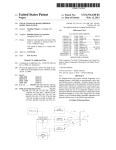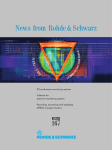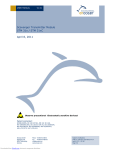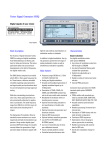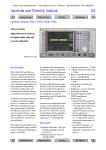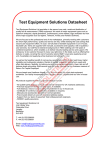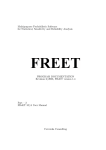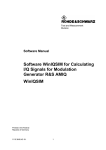Download Baseband Fading Simulator ABFS
Transcript
abfs_e.fm Seite 1 Freitag, 11. Februar 2000 10:46 10 Baseband Fading Simulator ABFS Saving costs through real-world fading tests • 2 fading channels (4 with option ABFS-B2) • 12 propagation paths (24 with option ABFS-B2) • Universal use in research, development and production • Simulation of present and future communication systems thanks to flexible concept • Receiver tests at I/Q level together with a baseband source • Ease of operation • High reliability abfs_e.fm Seite 2 Freitag, 11. Februar 2000 10:46 10 AMIQ The characteristics of a radio channel may strongly impair signal transmission between a transmitter and I/Q MODULATION GENERATOR ON CONTROL . AMIQ 1110.2003.02 I RUNNING Q in particular a moving receiver. MADE IN GERMANY Baseband Fading Simulator ABFS generates signals which simulate real receive conditions in mobile appli- I Q cations. Thus, the response of receivers under realworld conditions can be checked already during development and QM acceptance testing. The simulation of fading signals at baseband level reduces costs. ABFS Advantages of fading simulation in baseband Conventional fading simulators normally convert the signal of the radio channel to the IF, perform fading and then reconvert the signal to its RF fre- SMIQ I (faded) Q (faded) quency. It is however less costly to loop in the simulator prior to the first conversion to the carrier frequency, ie to simulate at baseband level (I and Q) and then convert to the correct fre- RF OUT quency in the test system (see Fig. 2). Signals will therefore not be impaired by the effects of multiple conversion. Due to this baseband fading simulation an upgrade to new networks or standards is easy. 2 Baseband Fading Simulator ABFS Fig. 1: Fading of a baseband signal from AMIQ with Fading Simulator ABFS abfs_e.fm Seite 3 Freitag, 11. Februar 2000 10:46 10 ABFS can also simulate frequency The basic model of ABFS comes with hopping systems. ABFS is fast enough two independent channels for 6-path Baseband Fading Simulator ABFS is to follow the frequency hopping of a fading. The two channels can be inter- suitable for universal mobile radio test system for example within a frame connected as follows (see Fig. 3): applications in research, development of 4,616 ms (GSM frame time). Fit for the future • Distribution of an input to two out- and production. It comprises all scenarios and statistical models for simu- Furthermore, an offset voltage for puts (eg with different fading pro- lating sporadic fading as specified in each I and Q input or output can be files). This feature makes it possible the test regulations of mobile radio entered to compensate external DC to simulate the signal of two anten- standards (eg GSM, IS-54/US-136 or offset voltages. nas with different characteristics or IS-95 CDMA). frequency diversity methods Together with a baseband source (eg • Simulation of two channels with in- The flexible concept of ABFS allows I/Q Modulation Generator AMIQ dividual profiles and addition at the simulation of radio channels of from Rohde & Schwarz, see Fig. 1 on output. Cell change or superposi- existing and future communication sys- the left) receiver tests can be per- tion of interferers can be tested with tems (eg mobile radio, broadcasting, formed at I/Q level even if the corre- this configuration flight telephone, WLL, or WLAN sys- sponding RF link is not available. Dur- tems). ing the development of receivers or channel with 12 propagation correction circuits in the receiver (eg paths is obtained (Fig. 4 gives a equalizer), the effects of fading can more detailled insight how the fad- thus be checked at a very early stage. ing simulator works). Test signal (incl. channel simulation) • Coupling of two channels so that a Output I,Q Channel 1 Input I,Q Channel 1 6-path fading Noise generator (optional) Test system I/Q - source I/Q - modulator I,Q output I,Q input + 6-path fading Fading Simulator I,Q Channel 2 I,Q Channel 2 ABFS Fig. 2: Fading simulation in baseband Fig. 3: Interconnections of ABFS Fig. 4: Schema of fading simulator DSP fading profiles path 1 gain variable delay x path 2 I,Q gain variable delay A I,Q x D + . . . + A + I,Q Noise generator path 6 variable delay ABFS-B1 (optional) D gain x from second fading simulator Baseband Fading Simulator ABFS 3 abfs_e.fm Seite 4 Freitag, 11. Februar 2000 10:46 10 High versatility by options Typical Rayleigh fading profile Noise Generator ABFS-B1 adds a noise source to the output of the first channel (see Fig. 3) so that noise can be simulated in the frequency band used. The noise generator can be switched on or off irrespective of the operating modes of the basic version. Second Fading Simulator ABFS-B2 offers two extra channels with the same characteristics in addition to the two channels of the basic model. Second Noise Generator ABFS-B3 represents an additional noise source for a further output. This second noise generator is either assigned to the second channel of the basic ABFS (with first noise generator ABFS-B1 for the Rayleigh fading (Doppler spectrum), generated at a speed of 180 km/h (RF = 1.8 GHz) first channel) or to the first channel of the second fading simulator ABFS-B2. Fading profiles of the Rayleigh, Rician, Pure Doppler, Lognormal or Suzuki method can be assigned to each of the propagation paths irrespective of the selected circuit (see Fig. 3). In addition to the fading profiles mentioned, the following parameters can be defined for each propagation path: • Path attenuation • Delay time • Doppler frequency or speed be- Why fading tests? • Coupling to another channel Interleaving is employed to overcome the problem of losing large tween transmitter and receiver Short-time signal fading, as caused parts of the messages. by multipath propagation, strongly Many fading models (eg GSM Rural affects the error rate of the received Resistance to fading is an essential Urban, Typical Urban) have already signal due to the short symbol peri- quality criterion of digital mobile been programmed in ABFS. The user ods in digital mobile radio radio systems and means a considerable competitive advantage for can quickly recall these default settings and also modify the parameters. Modern digital systems overcome the manufacturer. these problems with the aid of appropriate error control coding Tests with real-world signals using methods as well as algorithms for fading simulators are a must to spot delay equalizing. the weak points in new concepts at an early stage so that appropriate modifications can be made. Baseband Fading Simulator ABFS 4 abfs_e.fm Seite 5 Freitag, 11. Februar 2000 10:46 10 Noise power level in relation to fullscale level Range Resolution Error Specifications IQ inputs and outputs Impedance 50 Ω Input voltage for full-scale level Residual DC voltage at output Insertion loss of basic unit I + Q = 0.5 V <2 mV, fine tuning by software 0.3 dB Insertion loss between input and output 1 2 2 4 Output spectrum Bandwidth Frequency response up to 0.7 x system bandwidth (max. 5 MHz) RF system bandwidth4) Setting range Resolution Memory for device settings Storable settings Frequency response Output level at full-scale level (AC) 2 Fading simulation Number of propagation paths and fading channels Basic model with option ABFS-B2 Insertion loss between input and output at 0 dB path attenuation Frequency response up to 5 MHz offset from carrier frequency (corresponding to 10 MHz system bandwith) Path attenuation Range Resolution Error in range 0 to 20 dB Path delay Range Resolution Error Doppler shift Frequency range Speed range min. 9 dB Remote control System Command set Connector IEC/IEEE-bus address Interface functions +0.1 dB to −0.6 dB 0 to 50 dB 0.1 dB <0.3 dB 0 to 1600 µs 50 ns <5 ns General data Power supply 0.1 to 1600 Hz 0.03 ⋅ 10 9 m / s 2 fRF v max = 479 ⋅ 10 9 m / s 2 fRF For example at fRF = 1 GHz: vmin = 0.1 km/h, vmax = 1724 km/h Resolution Error Rayleigh fading Pseudo noise interval Deviation from theoretical CPDF1) at Pavg = 0 dB in range −20 dB to +10 dB in range −30 dB to −20 dB Rice fading Power ratio2) Range Resolution Frequency ratio Range Resolution Lognormal fading, Suzuki fading Standard deviation Range Resolution 0.1 km/h, m/s, mph <0.13 % >372 h Correlation Range for magnitude Resolution Range for phase Resolution RF setting Range (for each fading channel) Frequency hopping mode Interface Addressing of frequency list Electromagnetic compatibility Environmental conditions Operating temperature range Storage temperature range Climatic resistance Mechanical resistance Vibration, sinusoidal <1 dB, typ. <0.3 dB <2 dB, typ. <0.3 dB Vibration, random Shock −30 dB to +30 dB 0.1 dB Safety Dimensions (W x H x D) Weight −1 to +1 0.05 0 to 12 dB 1 dB lmin to 200 m, Local constant 2 2 I + Q = 0.5 V (= 4 dBm) 2 channel with 12 paths or channels with 6 paths each channels with 12 paths each or channels with 6 paths each v min = −17 to −50 dBfs 0.05 dB <0.3 dB lmin = 12 ⋅ 10 9 m / s fRF paths 1 to 6 with paths 7 to 12 of a channel (A or B) 0 to 100 % 5% 0 to 360° 1° setting of the RF results in an automatic calculation and display of the Doppler frequency according to the set motion speed3) 5 MHz to 8.5 GHz RF can be stored in a list and quickly set via a serial interface RS 232, 1 byte with start and stop bit 8 or 16 bit as address for each fading channel Setting time after frequency change <3.5 ms during Rayleigh fading Noise generator with options ABFS-B1 or ABFS-B3 Amplitude distribution Gaussian, statistically independent for I and Q Crest factor 14 dB 0, 6, 12 to 42 dB white noise depending on set system bandwidth <0.5 dB bandwidth determining noise power 10 kHz to 10 MHz 1% 50 −0.2 dB to −0.6 dB IEC 625 (IEEE 488) SCPI 1993.0 Amphenol 24-pin 0 to 30 SH1, AH1, T6, L4, SR1, RL1, PP1, DC1, DT1, C0 90 V to 132 V (AC), 47 Hz to 440 Hz, 180 V to 265 V (AC), 47 Hz to 440 Hz, autoranging, max. 300 VA meets EN 50081-1 and EN 50082-2 0 to 45°C, meets IEC68-2-1 and IEC68-2-2 −40 to +70°C 95% rel. humidity, cyclic test at +25/+40°C, meets IEC68-2-30 5 Hz to 150 Hz, max. 2 g at 55 Hz, 55 Hz to 150 Hz, 0.5 g const., meets IEC68-2-6, IEC1010-1 and MIL-T-28800D class 5 10 Hz to 300 Hz, acceleration 1.2 g (rms) 40 g shock spectrum, meets MIL-STD-810D, MIL-T-28800D, class 3 and 5 meets EN 61010-1 435 mm x 192 mm x 460 mm 20 kg when unit is fully equipped Ordering information Baseband Fading Simulator Accessories supplied ABFS power cable, operating manual 1114.8506.02 Options Noise Generator Second Fading Simulator Second Noise Generator ABFS-B1 ABFS-B2 ABFS-B3 1115.0009.02 1115.0309.02 1115.0609.02 Recommended extras 19’’ Rack Adapter Service Kit Trolley Transit Case Service Manual ZZA-94 SM-Z3 ZZK-1 ZZK-944 ABFS 0396.4905.00 1085.2500.02 1014.0510.00 1013.9366.00 1114.8564.94 1) 2) 3) 4) CPDF: cumulative probability distribution function Ratio between discrete and distributed component The phase differences between paths caused by different settings of path delay are taken into account when the RF is modified. This applies to frequency hopping mode only 0.5 x system bandwidth is used for baseband Certified Quality System ISO 9001 DQS REG. NO 1954 Baseband Fading Simulator ABFS 5 PD 757.5466.21 ⋅ Baseband Fading Simulator ABFS ⋅ Trade names are trademarks of the owners ⋅ Subject to change ⋅ Data without tolerances: typical values Printed in Germany 0200 (Bu we) abfs_e.fm Seite 6 Freitag, 11. Februar 2000 10:46 10 ROHDE&SCHWARZ GmbH & Co. KG ⋅ Muehldorfstrasse 15 ⋅ 81671 Munich, Germany ⋅ P.O.B. 8014 69 ⋅ 81614 Munich, Germany ⋅ Telephone +49894129-0 www.rohde-schwarz.com ⋅ CustomerSupport: Tel. +491805124242, Fax +4989 4129-3777, E-mail: [email protected]






